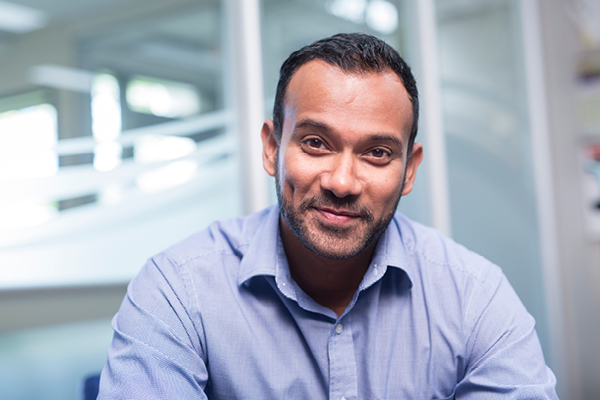
Co-Away: a digital tool to help northern communities address COVID-19
Co-created with Indigenous communities in northern Saskatchewan, the project leverages locally crowd-sourced data to make informed decisions.
By Monique Rodrigues/MitacsAT A GLANCE
The team
Mitacs Accelerate interns (University of Regina and University of Saskatchewan students), University of Regina professors, Lung Association of Saskatchewan, and community members of Île-à-la-Crosse, Saskatchewan.
The challenge
Address health risks for northern and Indigenous communities during the rapidly evolving COVID-19 pandemic.
The solution
Use the existing Smart Platform to leverage locally crowd-sourced data and develop the CO-Away app to support monitoring, mitigating, and managing the COVID-19 crisis.
What’s next?
The team is working with the Île-à-la-Crosse Citizen Scientists Advisory Council to define specific needs, develop CO-Away, and prepare for launch.
When the second wave of the Spanish flu hit Canada over 100 years ago, the effect was even more devastating than that of its first wave. In fact, 90 percent of the deaths happened in the fall of 1918, during the pandemic’s second peak.
The deaths were numerous across the country, but the mortality rate was notably higher in northern communities, in great part due to first contact with such viruses. “The wave comes slowly to remote communities, but it has a higher impact,” explains Dr. Tarun Katapally, a patient-oriented research leader and professor at the University of Regina’s Johnson Shoyama Graduate School of Public Policy.
Dr. Katapally is currently leading a Mitacs-funded research team on the development of a digital platform that will help monitor, mitigate, and better manage the spread of COVID-19 in Indigenous and northern communities.
The project’s structure comes from the existing Smart Platform, an evidence-based global digital policy tool developed by Dr. Katapally that integrates citizen science and community-based participatory research to assess health data and inform preventative policies. All data sourced is co-shared and co-owned with the communities involved.
“We wanted to work with a community that would benefit the most from our tool, and also be better prepared for multiple waves,” he explains.
Expected to be completed in phases over 15 months, the expedited project started in May and was one of the many that went through the fast-tracked Mitacs approval process especially for COVID-19 solutions.
Collaborating with Indigenous communities to tackle health challenges
The project will culminate with the creation of an app-based program called CO-Away, to be implemented as a pilot in Île-à-la-Crosse — a mostly Métis community in northern Saskatchewan. Based on the Smart Platform, the program is simultaneously a research and decision-making tool.
Through the platform, researchers gather health behavioural and outcome data that is shared by citizens. Different than a contact tracing app, it is grounded in real-time engagement with citizens, who will self-monitor and report symptoms and interactions while engaging with the research team as equal partners.
“What we’re trying to do is to give a voice to Indigenous peoples, and we’re using technology to do that,” Dr. Katapally explains. “And the data will support evidence-based containment strategies and policies.”
One of the first steps of the research was creating the Île-à-la-Crosse Citizen Scientists Advisory Council — which includes the town’s mayor, the CEO of the School Division, three high school students, two elders, and a social worker. Through discussing the community’s actual needs with the research team and sharing what they would like to see implemented, they are laying the foundation of CO-Away.
For instance, within the first meetings, the group understood that they would need to expand the tool beyond COVID-19 to tackle other needs such as developing mental health resources for youth.
“This technology could really put us in an advantageous position when it comes to health issues,” says Île-à-la-Crosse’s Mayor Duane Favel. “For example, by alerting people when they have a symptom, some of the health issues could be caught and addressed a lot sooner.”
For Favel, the collaborative nature of this project gives the community a sense of accomplishment as they’re able to follow its evolution and understand the benefits. He says that the members of the advisory committee are very excited and hopeful to engage all citizens.
Using smartphones to enable long-lasting health solutions

Three Mitacs interns — Luan Manh Chu, Sandeep Tandra, and Vignesh Shankar — will work on the project supervised both by Dr. Katapally and by Assistant Professor Alireza Manashty of the Department of Computer Science. They will be responsible for analyzing data, creating strategies for risk mitigation, and developing tools for ethical surveillance, knowledge translation, policy and behaviour interventions.
“This project can make a difference in mitigating the effects of such an unprecedented event like COVID-19, especially in vulnerable populations,” says Chu, a PhD candidate in the College of Medicine at the University of Saskatchewan. “I hope to contribute by linking citizens to healthcare services and potentially ensure safe social distancing and psychological support during all waves of the outbreak.”
Starting his internship in September, Chu will apply a set of skills related to his studies in health sciences and population health, including biostatistics and digital epidemiology. He will also gain from the unique professional development and networking opportunities enabled by the initiative.
A crucial partner in this project, the Lung Association of Saskatchewan, is enthusiastic about the potential health outcomes, as lung health in Indigenous populations is a pillar of their research priorities. The organization will support implementation and the work of the research interns, and facilitate scale-up.
“This project is an exemplary model of how innovation, partnership, and community participation can potentially improve lung health outcomes,” says Erin Kuan, President and CEO of the Lung Association of Saskatchewan. “We’re hopeful that this research can serve as a working model for other pandemics and other communities.”
As the COVID-19 pandemic continues to unfold, all the project’s collaborators are eager to see CO-Away available for download on the smartphones of Île-à-la-Crosse community members as soon as possible. The research team is working hard to launch the first version of the app already this year, and potentially start informing preventative policies that will enable enduring solutions.
This article was originally published on Mitacs' website.
Mitacs’s programs receive funding from multiple partners across Canada. We thank the Government of Canada, the Government of Alberta, the Government of British Columbia, Research Manitoba, the Government of New Brunswick, the Government of Newfoundland and Labrador, the Government of Nova Scotia, the Government of Ontario, Innovation PEI, the Government of Quebec, Fonds de recherche du Québec – Nature et technologies, the Government of Saskatchewan, and the Government of Yukon for supporting us in fostering innovation and economic growth throughout the country.

